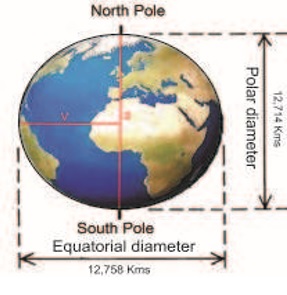There are different views/opinions about the shape of earth, such as – flat, spheroidal, oblate, elliptical and geoidal shape. So let’s discuss about the parameters of earth as well as circumference, diameter (polar and equatorial) and density of the earth.
Shape of Earth
Apart from the earth position in its orbit relative to the Sun, its spherical shape also plays a considerable role in distribution of climatic zones. Its spheroidal shape was discovered by Greek philosopher Pythagoras (574-479 B.C.). Our planet is in fact very close in shape to a sphere. The difference in the length of polar regions and equatorial radius is 21.5 kms. Earth is having shape of it’s own (geoidal) i.e. neither sphere nor a spherical oblate (flattened at poles and bulged at equator).
Circumference : 510 million Km3 in length

Diameter of the Earth

A slight flattering by 2mm, earth’s circumference is 510 million cubic meters in length.
V = Radius
D = Diameter
- Equatorial diameter = 12,757.776 kms
- Polar diameter = 12, 713.824 kms
- So, the difference = 43.952 kms.
Density of the Earth
The mass and density of the earth are found by the principle laws of physics. Thus the force of gravity at its surface is calculated by Newton’s Second Law. The mass is found to be 5.98×10²¹tones.
Read all articles >> Physical Geography